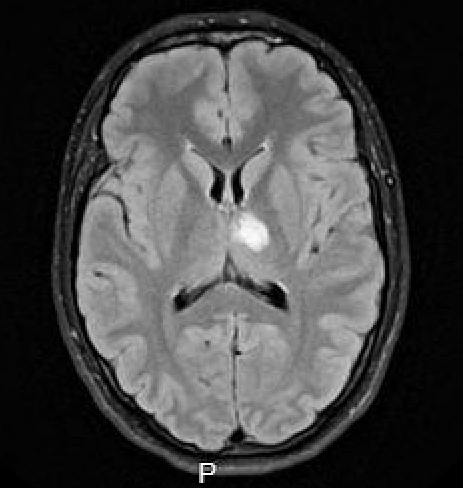Case Presentation: 21-year-old Caucasian male with no known medical history, has brought himself to the ED for evaluation of short-term memory issues. The patient denies any fever or chills, weakness, head trauma or similar complaints in the past. He exercises regularly, denies smoking alcohol or drug use. He has been using was finasteride since an year for male pattern baldness. On arrival his vitals were stable, examination showed he was slow to react, speech was pressured however he was able to answer all the questions. He was alert, awake, oriented, neurologic examination revealed short term memory gaps but no long-term memory issues, no signs of cerebellar dysfunction, and rest of the exam was normal. His labs were unremarkable. CT head showed a hypoattenuating left thalamic lesion concerning for a subacute infarct versus a demyelinating lesion. MRI revealed restricted diffusion of the left thalamus, consistent with an acute infarct. MRA head and neck, USG Venous doppler and CTPE were negative. Hypercoagulable workups were negative. TTE was normal, but TEE revealed a patent foramen ovale. Patient was started on aspirin, plavix and statin. As he was young and active, he was referred to tertiary care center, had a successful PFO closure and was asymptomatic on outpatient follow up. He was also advised to stop using finasteride due to its probable association with stroke.
Discussion: Symptomatic cerebral infarcts with a cryptogenic ischemic stroke have no known plausible etiology but up to half of young individuals with cryptogenic stroke had patent foramen ovale (PFO) (1). Finasteride used in male pattern baldness increases testosterone levels which are peripherally converted to estrogen, causing rise in their levels increasing the risk of thrombosis (2). For up to one-third of ischemic strokes in young individuals, cardioembolic stroke is to blame (3). PFO is about 20% more common in young stroke patients than it is in the general population (up to 50 percent). The enzyme 5-alpha reductase 2 is inhibited by finasteride causing decreased breakdown and increase in levels of testosterone which is peripherally converted to estrogen. Finasteride-induced elevations in estrone and estradiol levels have been linked to thrombus development. Four occurrences of stroke and four cases of other thrombotic illnesses have been recorded by the Japan Pharmaceutical and Medical Devices Agency (PMDA) among the 14 cases of thrombosis in finasteride-using patients in Japan (4).
Conclusions: We conclude that in young patients presenting with stroke, along with hypercoagulable work up, evaluation for PFO must be done. Young men less than 55 years old benefit significantly from PFO closure (5). If found, they must be referred to cardiothoracic surgeon for closure . We also recommend discontinuing finasteride as it increases the risk of thrombosis.

